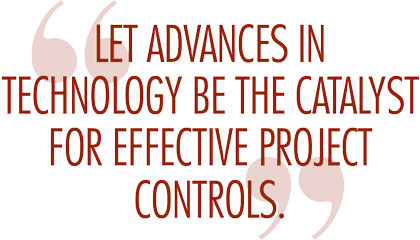Keeping the many parts of a construction project moving forward cohesively and efficiently is difficult work. Today, construction executives, contractors, and project managers are recognizing the value of project controls to help finish projects on time and on budget.
While the overarching concept of project controls is relatively new to the United States construction industry, its elements are familiar to all project managers. The three main pieces of the project controls puzzle are time, cost, and risk management. Put quite simply, project controls is part of the toolset used by project managers to keep track of a project, regardless of its complexity.
While project controls may sound simple, applying it correctly to each individual construction project takes skill and experience, and can be the differentiator for a successful project.
TIME MANAGEMENT
Let’s begin with time management, which encompasses so much more than just letting you know if a project is on time or late. Proper time management using project controls begins with the preparation of a solid baseline schedule. The best schedule is a planning tool, which shouldn’t function solely as a tracker of past work. Using Critical Path Method scheduling, the schedule should be updated each week or month to mirror the work in the field.
By using a forward-looking approach, a project manager can better understand what’s coming up—and prepare accordingly. For example, using a schedule could show what work is immediately critical, when submittals need to be approved, and when specific equipment is needed on site.

COST MANAGEMENT
Cost management is the second crucial part of project controls as it provides feedback on the health of a project from the cost perspective.
Contractors can cost load schedules to monitor monthly and total billings against their plan, which allows them to see if they are on track by measuring cash flow. Cost management can also simplify the payment process, as a cost loaded schedule becomes the payment application. This is an important feature for contractors who manage multiple subcontractors, as it saves time and eliminates confusion.
RISK MANAGEMENT
The third part of a successful project controls program is risk management. While instituting a risk management program requires a lot of effort, it pays off with significant results to construction projects. For example, a properly maintained risk management program identifies issues before they become impacts that cause delay or cost losses. Very rarely does a project go as planned. When something causes the plan to change, a good project controls program can assist a contractor to determine the best strategy to tackle a change to the plan and, hopefully, accommodate that change with no effect to the project.
A risk management program should start before a project commences with the identification of possible risks and what those risks can mean to a construction project. During the project, a risk management program can help separate the critical and non-critical issues, which will allow a project team to focus on the issues that need immediate involvement.
A successful project controls program provides contractors and all parties with valuable, unbiased information that can be put to immediate use to keep construction projects on time and on budget. Solid information and thoughtful analysis based on facts on the ground are the hallmark of a well-executed project controls program. ■
About The Author: David Hatwell founded Aegis Project Controls to help his clients keep construction projects on time and on budget. As president of Aegis, David applies his project controls expertise to create individualized project controls solutions for each client. David is a sought-after expert in scheduling and dispute resolution, and has scheduled over $20 billion of projects with a special focus on mega projects, such as military and corporate campuses and hospitals. www.consultaegis.com
_________________________________________________________________________
Modern Contractor Solutions, June 2015
Did you enjoy this article?
Subscribe to the FREE Digital Edition of Modern Contractor Solutions magazine.

On Time and On Budget


